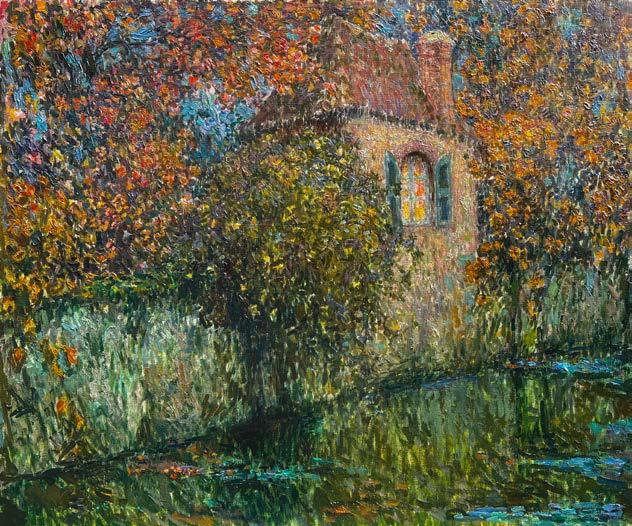
2 minute read
Charles Henri Verbrugghe
French, (1877-1974)
Few artists have cultivated an association with a city as strong as that between Charles Henri Verbrug-ghe and Bruges. Through brilliant colours and boldly textured brushwork, Verbrugghe set the standard for capturing the complex light of Bruges’ canals and medieval alleyways, setting a standard for depic-tions of the city that have rarely been matched.
Born in Bruges in 1877, and largely self-taught, Verbrugghe would move to Paris in 1905 and settle in Montmartre; at the time the epicentre of modern art. Forming close personal friendships with Maurice Utrillo and especially Kees Van Dongen, Verbrugghe would go on to socialise with Edgar Degas, Pierre-Auguste Renoir, and Claude Monet at the famous cabaret “The Lapin Agile” during his years in Paris.
Despite moving in Modernist circles, it would be the Impressionists who most influenced Verbrugghe’s mature style. Across a nearly eighty year career, Verbrugghe perfected his cityscapes in France and Italy, yet it would be his home town of Bruges, where he retruned to each summer, that exerted the great-est pull as a subject.
Pont du Cheval à Bruges, Le Soir
Oil on Panel
48 x 59 cms, 19" x 23"
Provenance
Private Collection, France.
Gladwell & Patterson, London ; acquired from the above in 2015.
Maurice Martin
French, (1894-1978)
A master of bold colours and strong form, Maurice Martin was a key practitioner in the Moret School of painting. Encouraged by a strong passion for landscape painting, Martin travelled to Moret sur Loing, not far from the more famous Barbizon region. There he became close friends with Henry Moret and his school of Impressionist painters, who lived and worked close to this picturesque town in central France, and who were themselves profoundly influenced by the innovative creativity of the four leading lights of Impressionism: Claude Monet, Pierre-Auguste Renoir, Camille Pissarro and Alfred Sisley. Martin was encouraged to practice ‘en plein air’ painting and the use of pure colour, believing that this technique was the only way to capture the immediacy of the outdoor scenery.
The technique used by Martin demanded a free and spontaneous style of painting in order to catch the rapid changes in outdoor light. Martin attempted to extract the colours and shapes as well as the fragrances of nature, putting the total ambiance and experience directly onto the canvas. As a general rule, artists from prior schools of classical training chose to absorb the experience of nature into mental and emotional images or perhaps even sketches and then return to the silent studio where they organized their thoughts and interpreted them onto canvas. Martin’s ethos was the complete opposite. The primary motivation for Martin, born out of the teachings of the Moret School, was to go through the woods with his paints and canvasses capturing a piece of nature at an exact prescribed time, thus eliminating the intellectual character of landscape painting. He believed that a landscape should be viewed purely as a moment of beauty.
Martin was a tall man and in his words, “saw from high up”. Yet his paintings are always impeccable in their perception, are well-lit and full of grace. His many landscapes include studies of Picardy, the Île-de-France, Brittany and Provence. He also painted in Spain, particularly in Grenada and Malaga, capturing with the tip of his brush the dances of sunlight he so much loved.
Pommiers en fleurs à Villemaréchal
Oil on Canvas
54 x 65 cms / 21" x 25½"
Provenance
Private Collection, Arles, France. Gladwell & Patterson, London; acquired from the above in 2022.
Evening Glow
Painted in 1916
Signed ‘Le Sidaner’ (lower left)
Oil on Canvas
65 x 81 cms / 25½" x 31¾"
Henri Le Sidaner
French, (1862-1939)
Provenance
Georges Bergaud (director of the Galerie Georges Petit).
Louis Loucheur; acquired from the above.
Private Collection, France.
Sale; Salle Galliéra, Paris, 18 June 1961, lot 51.
Private Collection, France.
Gladwell & Patterson, London, acquired from the above in 2022.
Literature
Yann Farinaux-Le Sidaner, Henri Le Sidaner : Paysages Intimes, (Editions Monelle Hayot, 2013), n°355, reproduced p.146.









